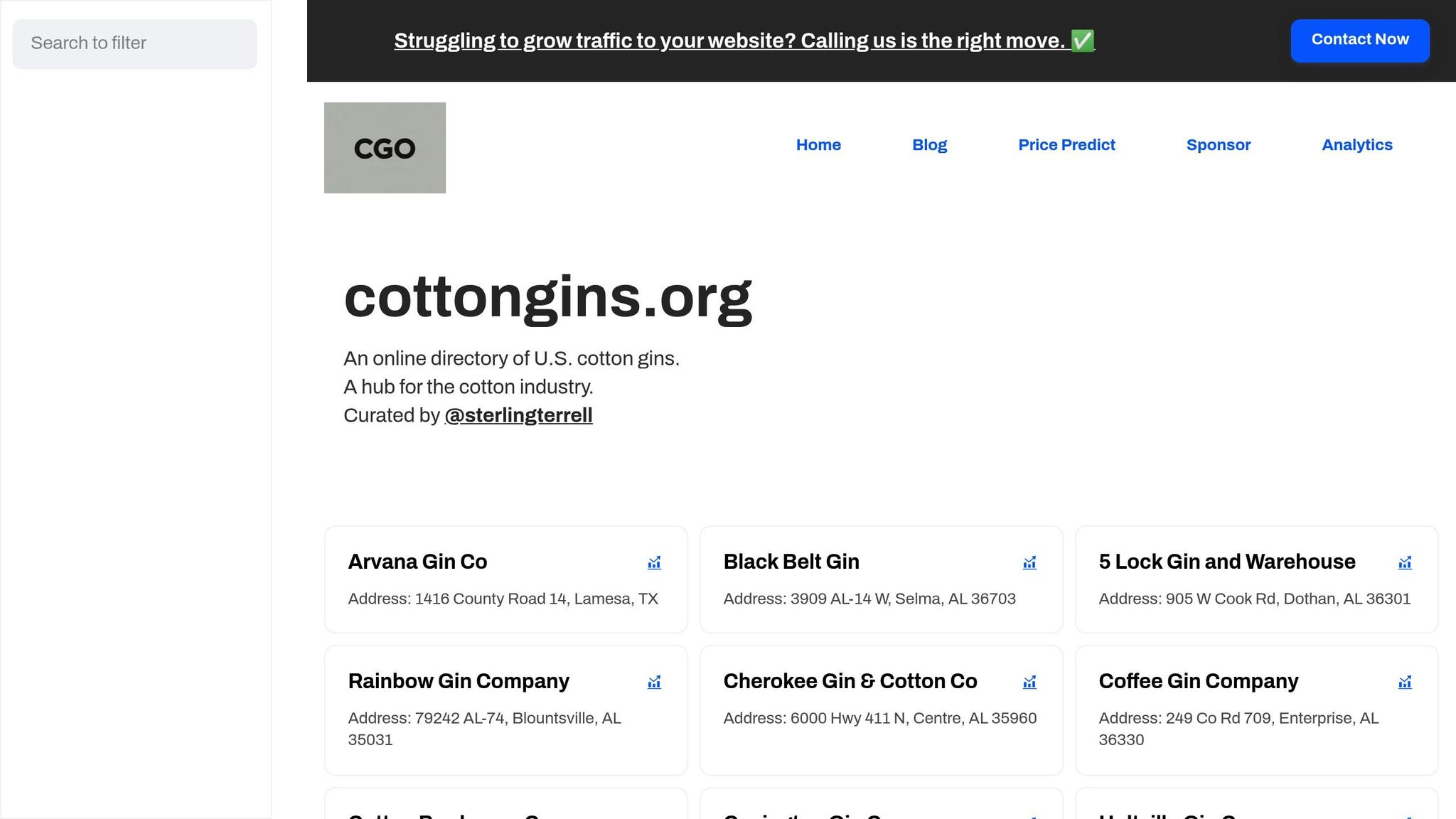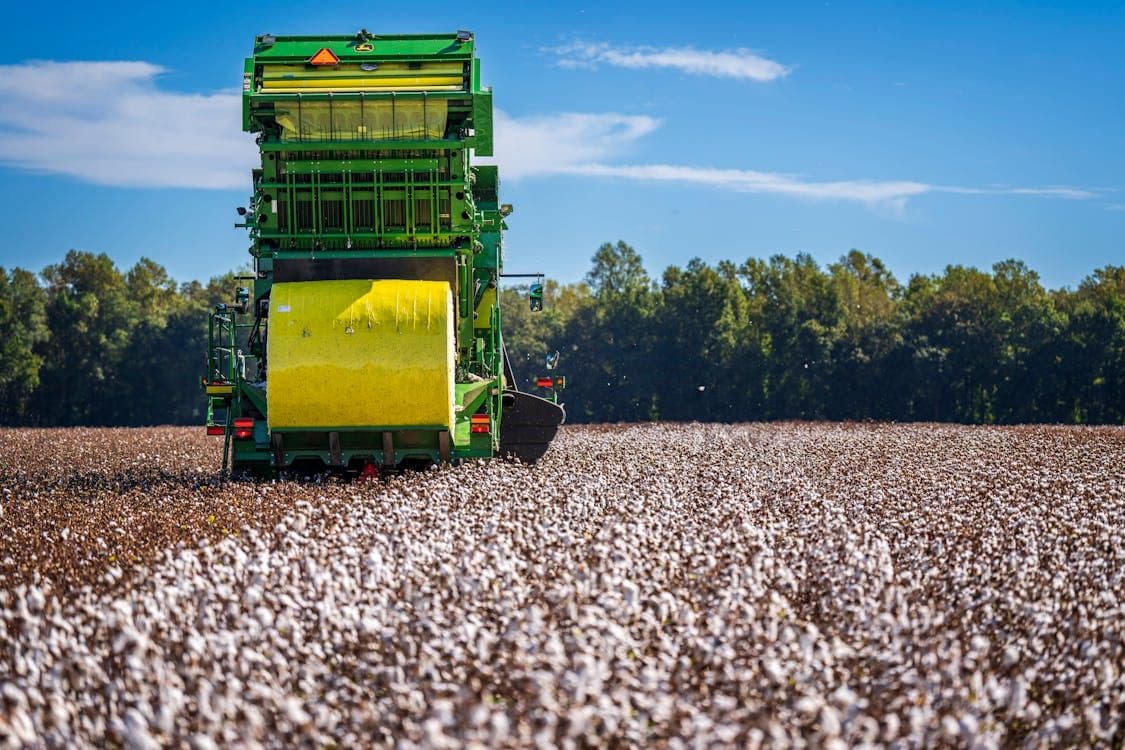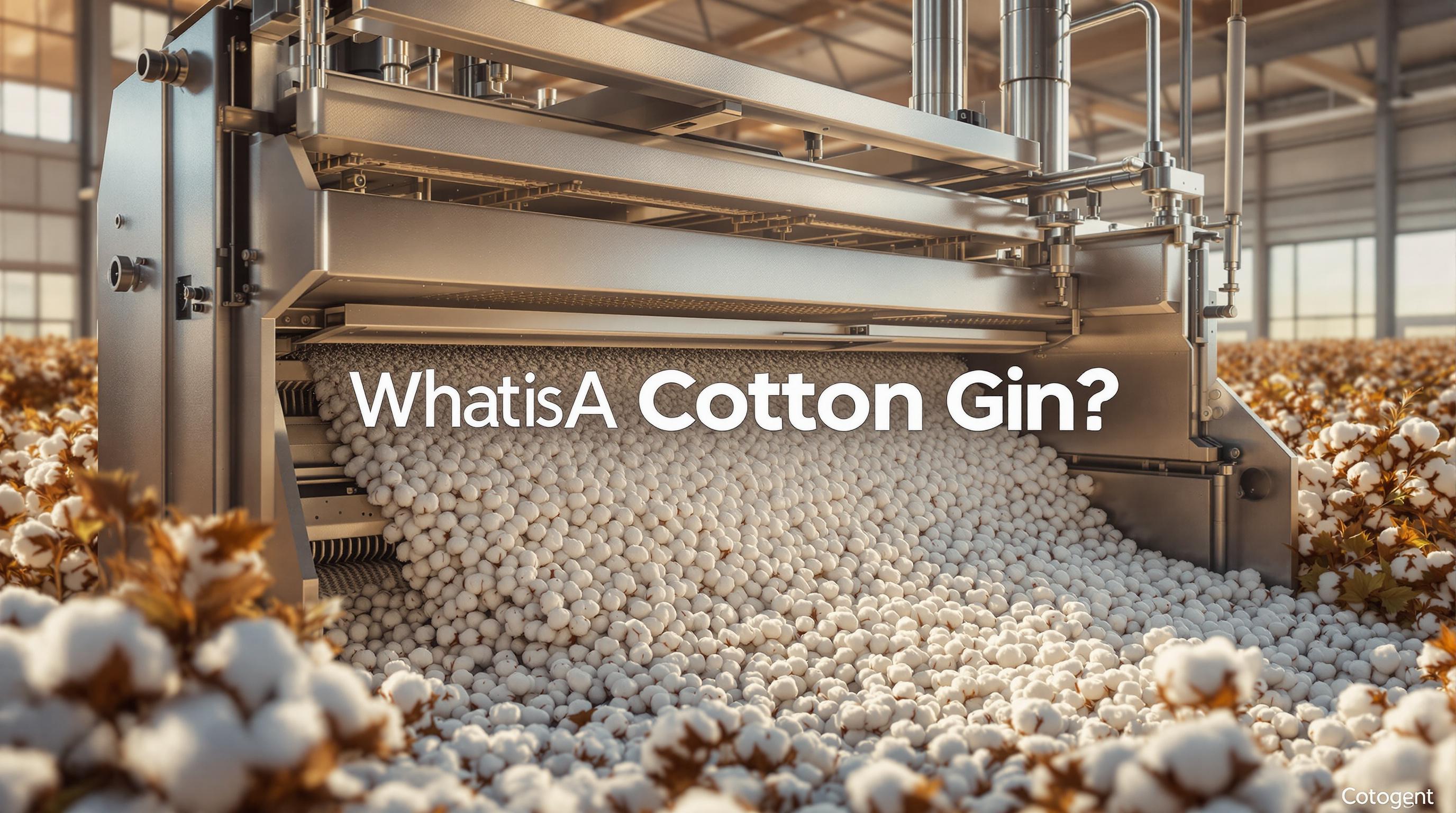Turning cotton waste into chemicals can create new revenue streams while solving waste disposal challenges. U.S. cotton gins produce large amounts of byproducts like stalks, leaves, and short fibers. Instead of discarding this material, advanced extraction methods can recover useful compounds for industries like cosmetics, pharmaceuticals, and bio-plastics. However, the financial success depends on the costs of setup, operation, and market demand for these chemicals. Here’s a quick breakdown:
- Key Methods: Microwave-assisted glycolysis, solvent dissolution, and pyrolysis - each with unique costs, energy needs, and outputs.
- Economic Metrics: Net present value (NPV), internal rate of return (IRR), and payback period are used to evaluate profitability.
- Market Potential: The global textile recycling market is projected to grow from $8.41 billion in 2025 to $11.88 billion by 2030, offering opportunities for cotton waste-derived chemicals.
- Challenges: High initial investments, energy demands, and regulatory compliance are hurdles.
The future looks promising, with advancements in technology and potential regional hubs making this process more accessible for U.S. cotton gins.
Using Cellulase Enzymes to Extract Glucose from Cotton Waste
Chemical Extraction Methods for Cotton Waste
Turning cotton waste into useful chemicals involves specialized techniques designed to efficiently separate and recover valuable compounds from complex plant materials. These methods differ in their energy needs, chemical outputs, and overall approach, allowing operators to choose the best fit for their specific waste streams and goals. Below, we break down the primary techniques, compare their characteristics, and explore the types of chemicals they can produce.
Main Extraction Techniques
Microwave-assisted glycolysis uses microwave energy to heat glycol solvents, breaking down cellulose and related structures within cotton waste. Thanks to its rapid and even heating, this method allows for precise reaction control. It’s particularly effective for processing cotton stalks and short fibers, breaking cellulose into smaller molecules that can serve as raw materials for products like plastics and resins. Compared to traditional thermal methods, it often produces cleaner outputs with fewer byproducts.
Solvent dissolution relies on solvents like ethanol or methanol to selectively dissolve specific compounds, leaving other materials behind. This method is commonly used to extract waxes, oils, and similar substances from cotton waste. Unlike high-temperature processes, solvent dissolution operates at ambient temperatures, making it less energy-intensive. However, its economic feasibility hinges on the implementation of systems to recover and recycle the solvents effectively.
Pyrolysis involves heating cotton waste in an oxygen-deprived environment, thermally breaking it down into gases, liquids (bio-oils), and solid char. Fast pyrolysis focuses on maximizing the yield of liquid products. This method can process a wide variety of cotton waste - such as stalks, hulls, and residues - without requiring extensive preprocessing. While it offers versatility, its high energy demands and the complexity of its outputs can be challenging.
Extraction Method Comparison
Here’s a quick look at how these methods stack up:
| Method | Energy Consumption | Scalability | Yield Quality | Main Limitations |
|---|---|---|---|---|
| Microwave-assisted glycolysis | Moderate | Medium-scale systems | Promising | Requires specialized microwave equipment |
| Solvent dissolution | Low | Highly scalable | Moderate | Requires solvent recovery systems |
| Pyrolysis | High | Highly scalable | Variable | High energy demands and complex outputs |
Each method comes with its own strengths and trade-offs. Microwave-assisted glycolysis offers a balanced option with moderate energy use and good yields but requires specialized equipment. Solvent dissolution is energy-efficient and scalable, though its success depends on solvent recycling systems. Pyrolysis is highly versatile, accommodating a range of waste types, but its energy needs and product complexity can pose challenges.
High-Value Chemicals from Cotton Waste
The chemicals derived from these processes vary in type and application, offering a mix of high-value and high-volume possibilities. For instance, cotton waste can produce monomers for bio-based polymers, as well as specialty chemicals like natural waxes and antioxidants, which are often used in premium applications.
Bio-oils extracted through pyrolysis can serve as heating fuels or be refined into components for transportation fuels. While the fuel market typically has lower per-unit prices compared to specialty chemicals, its large-scale demand makes it a viable option.
Additionally, cotton waste can yield industrial chemicals like organic acids, alcohols, and cleaning agents. Although these compounds may not command high individual prices, their steady demand across manufacturing sectors ensures a consistent revenue stream.
Economic Feasibility and Cost Analysis
The financial success of extracting chemicals from cotton waste hinges on three main factors: the initial capital investment, ongoing operational costs, and the market value of the recovered chemicals. Recent studies have shed some light on these costs, offering valuable insights for cotton gin operators.
Setup and Operating Costs
A 2021 study explored the production of semi-transparent bio-plastic from cotton gin trash and provided some key cost details. Electricity expenses were estimated at around $0.015 per gram of film produced, while chemical costs ranged between $0.13 and $0.14 per gram. Additional costs for raw material preparation - like cleaning, sizing, and drying - are relatively minor for many cotton gins, as these steps are often part of their existing operations. These cost factors play a significant role in determining how competitive these products can be in the market.
Market Demand for Extracted Chemicals
Strong market demand is essential to justify the upfront costs and ongoing expenses of chemical recovery from cotton waste. This process is gaining traction as part of the growing textile recycling sector. Globally, the textile recycling market is expected to expand from $8.41 billion in 2025 to $11.88 billion by 2030, reflecting an annual growth rate of 7.2%. In the U.S., the market is projected to hit $1.29 billion by 2032. Furthermore, textile waste worldwide represents an estimated $150 billion in lost raw material value. Scaling up processing capacity and achieving economies of scale are key to making chemical recovery more financially viable, even though recycled materials often come with a higher price tag compared to new raw materials.
Economic Comparison of Methods
Different chemical extraction methods carry varying cost implications, shaped by factors like capital investment, energy consumption, and recovery efficiency. For instance, solvent-based processes that recover 95% or more of the solvent can significantly improve overall cost-effectiveness. Choosing the best method depends on several factors, including available capital, local energy prices, and the specific market dynamics in play. Each approach has its own strengths and challenges, making it essential to weigh these elements carefully for optimal results.
sbb-itb-0e617ca
Benefits for Cotton Industry Operations
Chemical extraction is revolutionizing the way cotton waste is managed. By turning what was once a disposal problem into a source of revenue, this process not only addresses waste challenges but also improves efficiency and resource use across U.S. cotton operations. These advantages make it an attractive addition to routine gin operations.
Benefits of Cotton Waste Processing
Chemical extraction offers a practical solution for managing cotton waste while delivering environmental benefits. By diverting waste from expensive landfills, it reduces costs and helps curb methane emissions - a greenhouse gas with a warming potential about 25 times greater than carbon dioxide over a century.
This process also recovers valuable chemicals like cellulose and lignin, which can be used in industries such as pharmaceuticals and bio-plastics. These recovered materials create new income opportunities and contribute to a circular economy by reintroducing waste into the production cycle. Additionally, many extraction systems are designed to recycle water, which is especially beneficial in regions where water resources are limited.
Beyond the environmental impact, these systems also bring operational efficiencies, making them a win-win for the cotton industry.
Adding Extraction to Cotton Gin Operations
One of the biggest advantages of chemical extraction is how seamlessly it can integrate with existing gin infrastructure. Most cotton gins already have the necessary power systems, material handling equipment, and storage facilities to support extraction processes. Equipment like cleaning, sizing, and drying systems can also be repurposed, enabling a gradual and cost-effective integration.
While regulatory requirements vary by location, they generally follow well-established industrial processing standards. Facilities may need permits for air emissions, wastewater discharge, and chemical storage. However, modern extraction technologies are often designed to minimize emissions and reuse chemicals, which can simplify compliance with these regulations.
Operationally, the seasonal nature of cotton ginning offers additional flexibility. Extraction processes can run during off-peak times, allowing operators to manage waste without interrupting regular ginning operations. This approach ensures maximum use of equipment and improves overall efficiency.
Scalability is another key advantage. Operators can start small to test the process and market demand, then expand as needed. This phased approach minimizes initial risks and provides an opportunity to refine operations over time. These factors combine to improve the overall economic appeal of chemical extraction systems.
For those interested in exploring collaborations or identifying local facilities, the directory at cottongins.org offers a comprehensive listing of U.S. cotton gins, serving as a helpful resource for waste management initiatives.
Opportunities and Challenges for U.S. Cotton Gins
The idea of transforming cotton waste into high-value chemicals through chemical extraction is gaining attention. This process has the potential to increase revenue and improve operational efficiency for cotton gins. However, since research on the financial and operational impacts of these technologies is still in its early stages, many uncertainties remain. Below, we’ll dive into the potential financial benefits and the technical hurdles that come with adopting chemical extraction in ginning operations.
Revenue and Operational Benefits
Chemical extraction offers a way to diversify revenue streams while cutting down on disposal costs. While the exact financial benefits are still being studied, this approach aligns with the broader findings discussed earlier about improving the economic viability of ginning operations.
Implementation Challenges
Introducing chemical extraction into a cotton gin isn’t without its obstacles. It requires significant investments in specialized equipment, the development of updated safety protocols, and comprehensive training for staff to manage the new processes effectively.
Using Resources like cottongins.org

For cotton gin operators looking to overcome these challenges and explore new revenue opportunities, industry resources can make a big difference. One such resource is cottongins.org, a platform designed to connect operators with industry partners and foster collaboration. Through this directory, operators can find potential partners for joint ventures or shared processing arrangements, which can help offset the costs of initial investments and operational changes. Additionally, the platform offers sponsorship opportunities, allowing equipment suppliers and technology providers to connect directly with gin operators. This access to expert guidance and industry connections can be invaluable when navigating the adoption of emerging technologies like chemical extraction.
Summary and Key Findings
The study of extracting high-value chemicals from cotton waste highlights both opportunities and hurdles for the U.S. cotton industry. This technology has the potential to open up new revenue streams, but its financial and logistical demands require thorough evaluation before widespread adoption.
Main Analysis Results
The success of extracting chemicals from cotton waste largely hinges on factors like operational scale and market conditions. Larger facilities tend to deliver better financial results. However, the costs tied to capital investments can vary widely depending on the extraction method chosen. Additionally, ongoing expenses, including energy, labor, and maintenance, play a significant role in determining profitability. On the flip side, savings from reduced waste disposal costs and income from selling the extracted chemicals can improve the overall economic picture.
Collaboration within the industry can also boost economic outcomes. Partnerships - such as those supported by networks like cottongins.org - can help share risks and resources. Together, these findings point toward a promising direction for cotton waste processing.
Future of Cotton Waste Processing
The future of chemical extraction from cotton waste looks bright. As technology becomes more affordable, energy consumption and labor needs are expected to decrease, improving efficiency. Supportive government policies and incentives could further ease the financial challenges.
One promising strategy involves creating regional processing hubs - centralized facilities designed to serve multiple cotton gins. These hubs could achieve the scale needed to improve profitability while spreading the upfront investment among several operators. At the same time, advancements in next-generation extraction methods may drive down costs even further and increase chemical yields.
With these developments, combined with a growing demand for sustainable products, the U.S. cotton industry is well-positioned to benefit from these innovations. This progress underscores the role of chemical extraction in promoting environmentally friendly practices within the cotton sector.
FAQs
What are the environmental advantages of turning cotton waste into valuable chemicals?
Transforming cotton waste into high-value chemicals offers a range of environmental advantages. For starters, it significantly cuts down on water and chemical consumption, curbs wastewater pollution, and helps reduce greenhouse gas emissions that typically result from waste decomposition.
This approach also emphasizes recycling and conserving resources, decreasing the amount of waste sent to landfills and helping to preserve natural materials. On top of that, it lessens the environmental strain of cotton farming by lowering the demand for water and pesticides, encouraging a more sustainable lifecycle for cotton-based products.
What are the cost and energy differences between methods for extracting chemicals from cotton waste?
The method chosen for extracting chemicals from cotton waste plays a big role in both cost and energy efficiency. Take enzymatic hydrolysis, for instance - it’s capable of recovering up to 70% of glucose while using a moderate amount of energy, making it a promising option in terms of affordability. Other approaches, like microwave-assisted processes and solvent-based methods (which might use ZnO catalysts), are also gaining attention. Research suggests that microwave-assisted techniques, in particular, can cut down energy use significantly.
When compared to traditional chemical recycling methods, enzymatic and microwave-assisted techniques tend to use less energy and are often more budget-friendly. Still, their overall economic viability hinges on factors like the scale of production and progress in the technology itself.
What challenges do cotton gins face when extracting chemicals from cotton waste?
Cotton gins encounter a range of challenges when introducing chemical extraction methods for processing cotton waste. A key concern is dealing with chemical residues, which not only present safety hazards but also make it harder to repurpose materials effectively. On top of that, cotton waste often contains pesticides and other contaminants, necessitating comprehensive pretreatment to meet strict safety and environmental guidelines.
Another hurdle lies in managing the environmental footprint of these processes. This includes tackling emissions and responsibly handling waste disposal. Balancing regulatory compliance with cost-effective operations is no easy task, but it’s essential for ensuring long-term sustainability.


